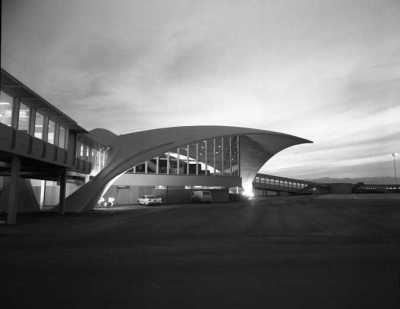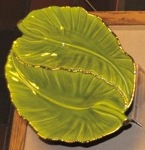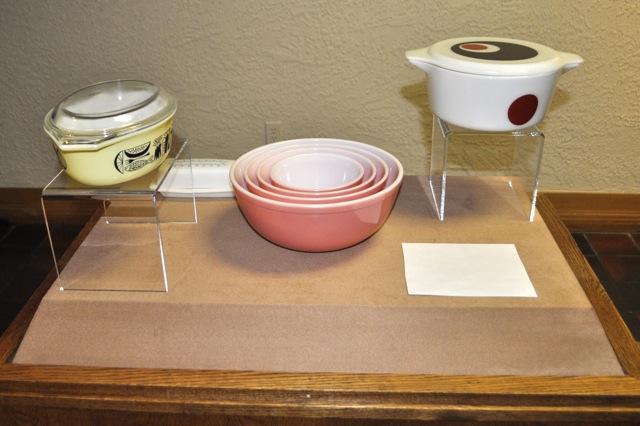Dateline: Las Vegas
Guest Blogger: Dennis McBride, Curator of History, Nevada State Museum, Las Vegas

When Lynn asked me to guest blog about the Nevada State Museum’s upcoming Mid-Century Modern Las Vegas exhibit, she wanted me to share how I chose the images that will be exhibited, and how I decided what examples of Mid-Century domestic and decorative arts to use in the cases.
Museum patrons who see finished exhibits don’t know what goes into building displays--they either like what they see or they don’t, and that depends upon how well or how badly the curator has put everything together. I work with a great deal of intuition, but once in awhile--accidentally, it seems--I work deliberately. Lemme see what I can tell you about our new exhibit.
To be frank, I didn’t know very much about Mid-Century Modern architecture and style until the Lynn and the museum sponsored the Mid-Century event last October 3. I got hooked, and wanted to do something with material that no one had seen before, or had not seen in more than a generation. The museum has in its archives the photograph collection of J. Florian Mitchell, who was renowned as a photographer in New York in the 1920s, ‘30s, and ‘40s, before coming to Las Vegas in the early 1950s.
When I came to work here in 2007, part of my self-appointed task was to reorganize the photo collection and make it more accessible. When I dug through Mitchell’s thousands of prints and negatives in the museum’s vault, I was astounded at the breadth of his Las Vegas subjects, which included images photographers ordinarily wouldn’t care much about recording. In addition to hotels, casinos, and Las Vegas celebrities, I found images of long vanished shopping centers, banks, motels, restaurants, schools, and government buildings. Nearly all of these were taken in the 1950s and ‘60s, during the height of the Mid-Century Modern movement. I saw images that gave me an entirely different idea of what Las Vegas once looked like, and how perfectly it fit into the Mid-Mod style for a relatively brief period of time. How could I publicize these photos in a way that would inspire Las Vegans to look at their city’s past in a different way? Motivated by Lynn’s enthusiasm, I started planning a Mid-Century Modern exhibit of Las Vegas’s past.
With so many images to choose from, how would I pick what best represented Las Vegas architecture in the 1950s and ‘60s? Lynn made an initial search through the collection, and I made a second and third, mining the negatives for what I thought people might like to see. Rather than choose images of familiar landmarks, I largely chose photos of buildings that are either vanished or so changed that their present appearance bears no resemblance to the original. For example, the original McCarran International Airport today seems mysterious, alien, and beautiful in its Mid-Modern simplicity. The original rotunda of the Las Vegas Convention Center seems far more substantial than the present stack of boring blocks. Maude Frazier Hall at UNLV sits behind its lawn looking cool, elegant, and more inviting than the gravel lot that replaced it last year. With these and other images, I’ve tried to show that Las Vegas then was far more architecturally daring and beautiful than it is today.

So far, so good for the images--but I also wanted the exhibit to ground patrons in that period in a way that two-dimensional images cannot. I needed artifacts that people could relate to personally. I decided to include an exhibit of Mid-Century “domestic and decorative arts.” Think dishes, pots and pans, utensils, ashtrays, vases, cook books and recipe boxes. How would such objects convey a sense of Mid-Century modernity? Through their shape, their material, and their use. When people think of the 1950s and ‘60s from this perspective, they think of Pyrex, Tupperware, and Melmac; they think biomorphic, boomerangs, parabolas, rounded squares, domes; they think pink, turquoise, and chartreuse. We took those shapes and colors as the frame for the exhibit hall, and then I went on a six-month search through Goodwill, Salvation Army, Savers, and whatever yard sales I drove by for exhibit items. I built a case of colorful melamine dishware; fanciful Pyrex casseroles, carafes, butter dishes and nested bowls; bright orange Tupperware measuring spoons; a set of Russel Wright’s American Modern dishes in chartreuse, with their strange biomorphic shapes; a vintage Teflon-coated sauce pan with a sweeping lid; a garish green-and-gold leaf dish from a California pottery; and a black, understated Hyalyn pottery bowl.

These are artifacts to which people can relate: Grandma cooked green-bean casseroles in a Pyrex bowl just like that Moon Deco piece with the big red dot; Mom kept a pair of Scandinavian Modern candlesticks just like those on the sideboard in her dining room; my uncle, who smoked Chesterfields, kept an ashtray like that on his nightstand; we thought nothing of eating chicken rolled in bleached white flour and fried in Crisco.
That’s how we did it, and we hope you like it. Mid-Century Modern Las Vegas will be the last major exhibit the Nevada State Museum presents before its move in 2011 to new digs at the Las Vegas Springs Preserve.




